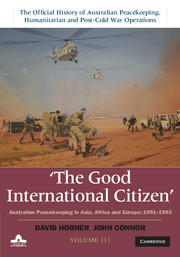Book contents
- Frontmatter
- Contents
- Maps
- Preface
- Chronology 1989–99
- Abbreviations
- Part 1 Strategy and policy
- Part 2 Cambodia
- 3 From Angkor Wat to Pol Pot
- 4 Law and order on the border
- 5 An Australian peace proposal
- 6 First into Phnom Penh
- 7 The roadblock
- 8 Change in plan
- 9 ‘Democracy's surprise triumph’
- 10 Developing Operation Banner
- 11 Winding up Operation Banner
- Part 3 Western Sahara
- Part 4 Former Yugoslavia
- Part 5 Watch on Iraq
- Appendix A United Nations Security Council resolutions
- Appendix B Major office bearers, 1991–99
- Bibliography
- Index
- Plate section
- References
8 - Change in plan
Australians in the UN Transitional Authority in Cambodia, June–December 1992
from Part 2 - Cambodia
Published online by Cambridge University Press: 12 May 2022
- Frontmatter
- Contents
- Maps
- Preface
- Chronology 1989–99
- Abbreviations
- Part 1 Strategy and policy
- Part 2 Cambodia
- 3 From Angkor Wat to Pol Pot
- 4 Law and order on the border
- 5 An Australian peace proposal
- 6 First into Phnom Penh
- 7 The roadblock
- 8 Change in plan
- 9 ‘Democracy's surprise triumph’
- 10 Developing Operation Banner
- 11 Winding up Operation Banner
- Part 3 Western Sahara
- Part 4 Former Yugoslavia
- Part 5 Watch on Iraq
- Appendix A United Nations Security Council resolutions
- Appendix B Major office bearers, 1991–99
- Bibliography
- Index
- Plate section
- References
Summary
On 23 July 1992, less than two months after the Khmer Rouge stopped the Secretary-General's Special Representative Yasushi Akashi and Untac Force Commander Lieutenant General John Sanderson from travelling out of Pailin, another group of travellers were cleared for a much longer journey from Phnom Penh's Pochentong airport. Thirty-three sculptures from the Cambodian National Museum, between 1500 and 800 years old and weighing 9 tonnes in total, prepared and packed by staff of the Australian National Gallery, were carefully loaded over five hours by RAAF personnel and Australian members of the Untac Movement Control Group aboard a C-130 Hercules transport aircraft of No 36 Squadron for a flight to Bangkok, the first stage of their odyssey to Canberra. Here, they would be displayed in The Age of Angkor exhibition and be seen by more than 30 000 people between 22 August and 25 October 1992. The Cambodian decision to lend these precious works of art to the National Gallery in preference to rival offers from European and North American institutions was recognition of the Australian role in supporting the Cambodian peace process. The exhibition also showed that broader links were developing between Australia and Cambodia alongside the peacekeeping mission. The National Gallery trained Khmer staff in art conservation, and sales of the Australian exhibition's catalogue funded the Cambodian National Museum's purchase of a four-wheel-drive vehicle to enable the safe transport of artefacts found in the countryside to Phnom Penh. At a time when the Khmer Rouge's stubborn violence imperilled the chances of Cambodian peace, these serene sculptures provided hope, as Deborah Jones wrote in the Australian, ‘that civilisation does outlive tyrants’.
- Type
- Chapter
- Information
- The Good International CitizenAustralian Peacekeeping in Asia, Africa and Europe 1991–1993, pp. 169 - 192Publisher: Cambridge University PressPrint publication year: 2014

